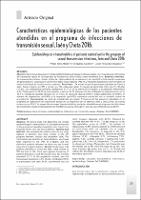Características epidemiológicas de los pacientes atendidos en el programa de infecciones de transmisión sexual, Jaén y Chota 2016
Related Resource(s)
http://cmhnaaa.org.pe/ojs/index.php/rcmhnaaa/article/view/42Date
2018-09-08Author(s)
Mena-Mejía, Wilser
Quiroz-Sánchez, Erick
Fernández Mogollón, Jorge Luis
Metadata
Show full item recordAlternate title
Epidemiological characteristics of patients carried out in the program of sexual transmission infections, Jaén and Chota 2016
Abstract
Objetivo: Determinar las características epidemiológicas de los pacientes atendidos en el programa de infecciones de transmisión sexual en los hospitales de los distritos Jaén y Chota, enero-diciembre 2016. Material y métodos: Se revisaron las historias clínicas y libro de registro diario de los pacientes; se completó la información a una base de datos de Excel, la que posteriormente se exportó al programa SPSS 21, y el análisis estadístico entre variables se realizó utilizando el estadístico chi cuadrado. Resultados: Se encontró que los pacientes atendidos en Chota y Jaén, fueron mujeres en 90% y varones en 10%, hubo una mayor frecuencia de pacientes entre los 21 y 30 años (37,8%). Las trabajadoras sexuales representan el 37,1% de la población estudiada, y la población homosexual 4,6%. Chota aportó un 40,5% de participantes y Jaén un 59,3%. Gardnerella fue el diagnóstico más frecuente con un 43,9 %, seguido de cándida albicans con un 14,6%. El rango de edad (p<0,03) el grupo poblacional (p<0,001), el número de diagnósticos (p<0,001) y la ocupación (p<0,001) mostraron asociación con la variable ciudad de procedencia. Conclusiones: La zona de procedencia con mayor frecuencia de los pacientes atendidos en el programa de infecciones de transmisión sexual en los hospitales de los distritos Jaén y Chota 2016, es la zona urbana con un 78,6%. La ocupación con mayor frecuencia de los pacientes atendidos en el programa de infecciones de transmisión sexual en los hospitales de los distritos Jaén y Chota 2016, es la de no profesional con un 68.9%. Objetive: The aim of study is to determine the clinical
epidemiological characteristics of the patients treated
in the program of sexually transmitted infections in the
hospitals of the Jaén and Chota districts. Material and
Methods: We reviewed the medical records and daily
logbook of patients who were treated in the STI
program between January and December 2016; The
information was added to an Excel database, which was
later exported to the SPSS 21 program, and the
statistical analysis between variables was performed
using the chi-square statistic. Results: It was found that
patients attended in Chota and Jaén, were women in
90% and men in 10%, there was a greater frequency of
patients between 21 and 30 years (37.8%). Sex workers
represent 37.1% of the population studied, and the
homosexual population 4.6%. Chota contributed 40.5%
of participants and Jaén 59.3%. Gardnerella was the
most frequent diagnosis with 43.9%, followed by
candida albicans with 14.6%. The age range (p <0.03)
the population group (p <0.001), the number of
diagnoses (p <0.001) and occupation (p <0.001) showed
an association with the variable city of origin.
Conclusion: The frequency of diagnosis in the first
place was Gardnerella with 38.9%, followed by candida
albicans 13.8%, chlamydia 8.7%, trichomona 7.8%,
syphilis 7.5%, candida albicans / Gardnerella 5.4%,
gonorrhea 2.8%, HIV 3.2%, herpervirus 1.7%, and others
in a lower percentage. The gender most frequently was
the female sex by 90% while the male sex by 10%. The
most frequent age group was the 21- to 30-year-old
with 37.8%. The highest level of education was 34.2% of
secondary education.






